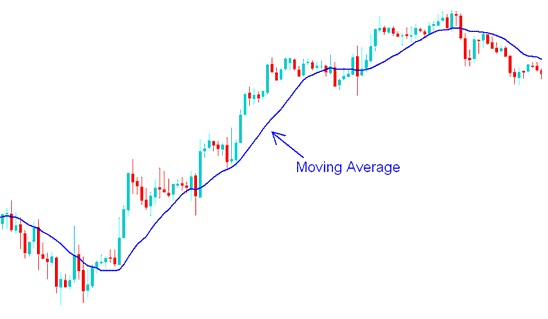20 Period Moving Average Strategy
A trader can select a moving average to employ based on their primary trading timeframe. For instance, a trader might select a moving average suitable for trading on a 1-minute chart, a 1-hour chart, a 4-hour chart, a daily chart, or even a weekly chart.
Traders pick close, open, or median prices for Moving Averages.
Moving average is oftenly used to estimate momentum of trends. The data of the moving average is precise & its output as a line can be customized to the preference of a indices trader.
A simple way to get buy and sell signals is by using the moving average indicator, which helps you trade along with the price trend, because it follows behind and is a trend-following tool. Because the Moving average indicator follows behind, it usually gives signals later than other indicators that predict ahead. But, the MAs Moving Averages indicator as a lagging indicator is often more correct and gives fewer false signals than the indicators that predict ahead.
Traders customize moving average periods according to their trading approach. Options may include short-term, medium-term, or long-term styles based on individual preferences.
- Short term trading: 20 Period MA Strategy
- Medium term trading: 50 Period Moving Average MA Strategy
- Long term trading: 100 Period MA Trading Method
The Moving Average (MA) period duration can be measured across the 1-minute trading chart, the 1-hour chart, the 4-hour chart, the daily chart, or even the weekly chart. For this indices trading strategy example, we will select the 1H chart time resolution.
Short-term moving averages respond quickly to stock price movements and can indicate trend signals sooner than long-term averages: however, they are also more vulnerable to whipsaw signals compared to their longer-term counterparts.
Longer-term moving averages are useful for filtering out false signals but are slower to accurately signal the emergence of new trends or reversals.
Because long-term moving averages calculate the price average using more stock price data points, the long-term moving average does not reverse as fast as a short term moving average & it is slow to catch the changes or reversals in the trend. However the longer term moving average is better when the market trend stays in force for a longer time.
The task of a trader is to find a moving average period that will spot trends as early as possible while the same time avoiding fake out signals -indices whipsaws. As a trader you will need to first test different moving average periods before deciding which moving average period is best fitted for your trading style method based on the results of the testing which you will do using different moving averages.
MA Period Strategy
Used for three main purposes by traders, the moving average indicator tracks the prevailing market trend.
- Spotting the beginning of a new trend
- Measure the sustainability of the new trend
- Identify the end of a trend & signal a market trend reversal
The moving average indicator helps smooth out stock price volatility. As an overlay indicator, it is displayed directly on the price chart for clearer analysis.
On the moving average illustration explained and shown below - the blue line represents a 20 period moving average, which acts to smooth out the volatility of price action.

100 Period Moving Average MA Method - MA MA Period Strategy - MA MA Strategy
Calculation of the Moving Average MA Price Period
The moving average is calculated as an average of stock price using the most recent stock price data point -indices periods.
A moving average over 20 periods is a 20-period one. Traders often use daily charts for stocks. So we call it the 20-day moving average.
To find the 20-day moving average, the prices from the last 20 days are averaged, and the average is updated constantly when each new stock price period ends: so after each new stock price period, the average is recalculated using the latest 20 periods, which is why it's called a moving average MA, because the average moves as stock price data updates and is recalculated.
Learn More Courses & Guides:

